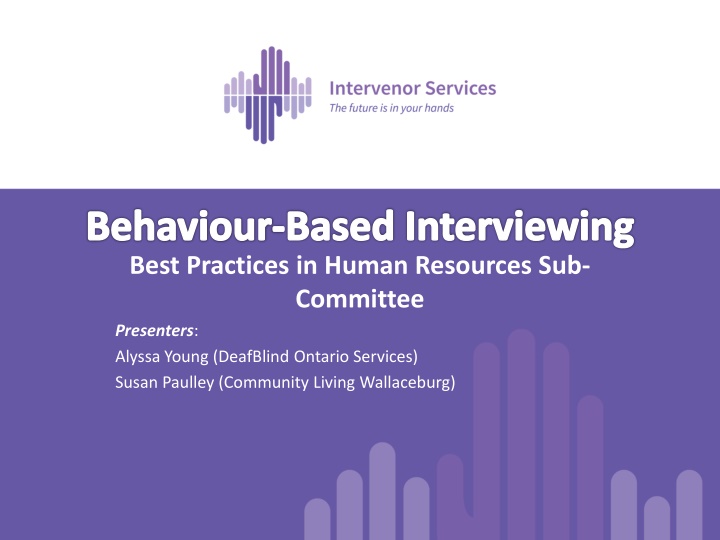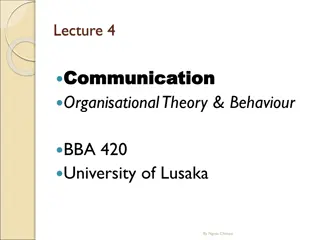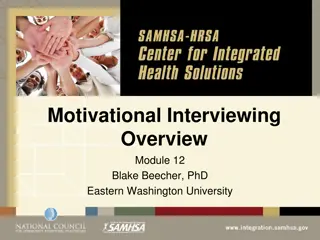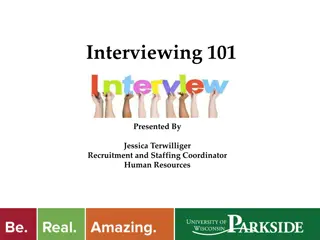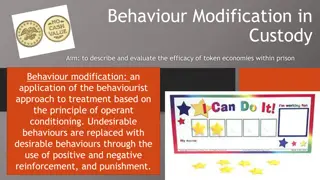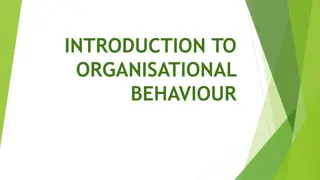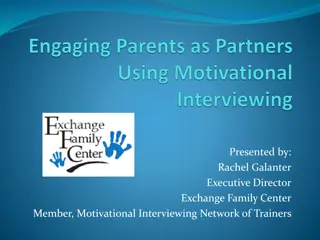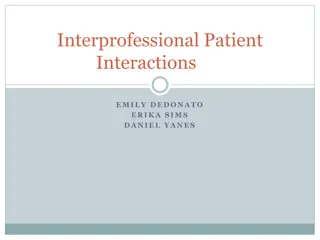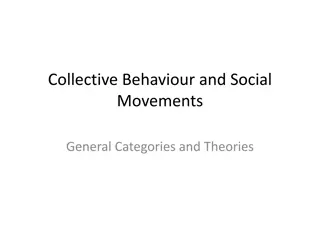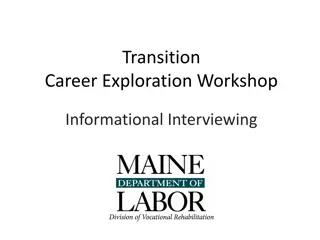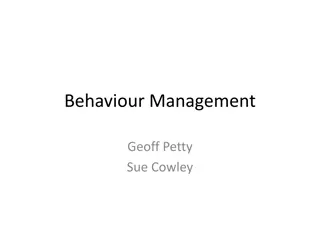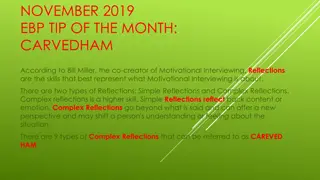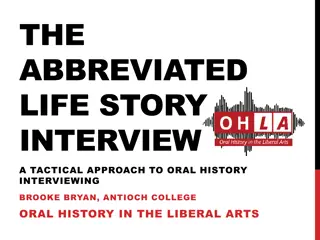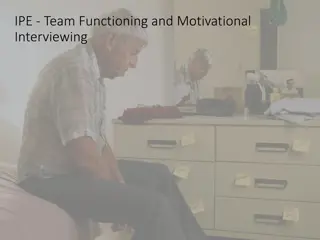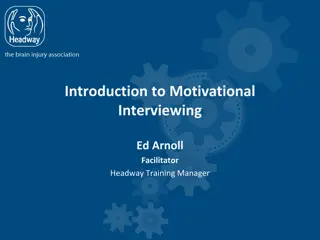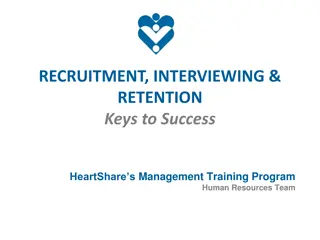Behaviour-Based Interviewing Best Practices in Human Resources
Presenters discuss best practices for behaviour-based interviewing in human resources, covering topics like the cost of hiring mistakes, selection methods validity, and competency-based approaches for employee selection, development, and promotion.
Download Presentation

Please find below an Image/Link to download the presentation.
The content on the website is provided AS IS for your information and personal use only. It may not be sold, licensed, or shared on other websites without obtaining consent from the author.If you encounter any issues during the download, it is possible that the publisher has removed the file from their server.
You are allowed to download the files provided on this website for personal or commercial use, subject to the condition that they are used lawfully. All files are the property of their respective owners.
The content on the website is provided AS IS for your information and personal use only. It may not be sold, licensed, or shared on other websites without obtaining consent from the author.
E N D
Presentation Transcript
Behaviour-Based Interviewing Best Practices in Human Resources Sub- Committee Presenters: Alyssa Young (DeafBlind Ontario Services) Susan Paulley (Community Living Wallaceburg)
Icebreaker Name Role and tenure Expectations for the session Worst interviewing nightmare (either as interviewer or interviewee)
Objectives Build capability in behaviour-based interviewing and assessing candidate information for evidence of competencies by: Practicing conducting behaviour-based interviews Taking effective notes Coding candidate data for competencies
Agenda Welcome, introductions, objectives and agenda Introduction to behaviour-based interviewing The behaviour-based interview process Getting codable data Practice round 1 Practice round 2 Assessing the candidate Making a selection decision Final reflection Training Feedback
A question What is the cost of making a hiring mistake?
The cost of a hiring mistake Consider the costs associated with Advertising for the position Administrative costs associated with the recruitment and selection process (e.g., pre-employment assessments, background checks, etc.) Interview expenses Salary and benefits paid to the employee Orientation and training Loss of productivity Missed opportunities Lower morale Poor job/person fit and the negative impact
Selection methods and their validity 0.7 0.65 0.6 0.61 0.5 0.54 0.53 0.4 0.39 0.38 0.3 0.2 0.23 0.18 0.15 0.1 0.10 0.10 0.10 0 Non structured interview Behaviour-based interview Assessment centre Experience Cognitive ability tests Performance appraisals Work sample References Personality tests Work interest Age Biodata
Using a competency-based approach for selection Will help to avoid these costs by providing a framework to consistently select, develop and promote employees Will help to avoid these costs by providing a framework to consistently select, develop and promote employees
Introduction to behaviour-based interviewing
What is behaviour-based interviewing? A structured interview that is used to collect evidence about past behaviour competencies Uses targeted competency-based questions to gather evidence of the candidate s competencies relative to the competencies required for success in the role Based on the premise that past performance predicts future performance Uncovers behavioural and technical skills Reduces tendency toward interviewer bias candidates typically view this type of interview as fair and equitable Increases objectivity and accuracy in selection decisions
The goal a good job-person fit Different jobs require different competencies Different working environments require different competencies It is important to get the right job-person fit
Traditional Interviews Ask the candidate how they would behave as opposed to how they did behave (e.g., What would you do in this situation ? ) Are usually insufficient to identify the highest potential job candidates May result in more biased and/or ineffective selection decisions
Behaviour-based interviews Ask the candidate questions that elicit how they have demonstrated specific behaviours in the past (e.g., Tell me about a time when you had to . ) Reduce the candidate s ability to be less than honest Typically result in more effective and unbiased selection decisions
Behaviour-based interviews avoid these mistakes made in traditional interviews Interviewer talks more than the candidate Selection decisions based on first impressions or gut instincts Interviewer asks inappropriate or potentially illegal questions The same general questions are used for every position, making it difficult to judge if a candidate is right for a specific position Interviewers disagree on which candidate to hire due to a lack of agreement on criteria for success
The behaviour-based interview process
Pre-interview preparation In preparation to conduct a behaviour-based interview, you will need to: 1. Define the job requirements (refer to the job description): What are the key accountabilities for the position? What are the credentials, qualifications and/or educational requirements you are seeking in the candidate? What technical skills are required? What experience, if any, is required? Which competencies are required for the position?
Pre-interview preparation, continued 2. Design the selection process: Identify who will be involved in the interview process Determine the screening process Determine the interview process, including: How many interviews will be conducted with candidates? Who will conduct the interviews? Which competencies will be explored with the candidate (Note: If conducting multiple interviews or using multiple interviewers, determine which competencies will be covered in each interview and/or by each interviewer.) Who will set up the logistics of the interview process? Will there be any additional assessments or testing required as part of the interview process? Arrange a meeting to evaluate candidates and make a selection decision Plan the reference check process
The behaviour-based selection funnel Multiple hurdle process Broad, less costly assessment methods used to pre-screen candidates Specific, more labour intensive assessment methods used to assess individual competencies
Pre-interview preparation, continued 3. Review/prepare the Behaviour-Based Interview Guide A key tool to guide you through the interview It includes: A script of the key points to cover in the interview The competencies for the role Identify which competencies to explore with the candidate Targeted selection questions for each competency Identify which questions you will ask Space for taking notes during the interview
Phase 2: Conduct the interview 3. Specific recent events targeted selection questions 1. Open the Interview and establish rapport 4. Ask any final questions 5. Give the candidate an opportunity to ask questions 6. Close the interview 2. Career History 5 40 3 5 2 5 minutes minutes minutes minutes minutes minutes
1. Open the interview Use the opening to build rapport and make the candidate feel at ease: Greet the candidate Introduce yourself and your role Ask a question such as Did you have any problems finding our office today? Are you enjoying the weather? Explain the purpose and structure of the interview Mention: Timeframe for the interview Note-taking
What questions would you ask a candidate to explore their career history?
2. Review the candidates career history Review the candidate s career history and key job responsibilities starting with the most recent position Probe for more information about the candidate s technical knowledge, education and expertise, as appropriate Ask the following types of questions: What is/was your position? What are/were your responsibilities? Do/did you have any direct reports? If so, how many? What key skills are/were required in the job? What technical abilities do you possess that you feel are relevant to this job? How have you demonstrated these skills/abilities? Which of your previous positions do you feel most prepares you for this job? Explore any gaps in employment Remember to ask the candidate what caused them to make the job choices they did along the way.
3. Conduct the behaviour-based interview Explain the process for the behaviour-based component of the interview: You will be asking them to share several stories within the last 1-2 years For each story, have candidates describe the: Context have the candidate provide a brief overview of the situation or challenge (2-3 sentences) to give you the context Actions have the candidate describe the actions he/she took in the situation Results have the candidate describe the results/outcome You will likely be interrupting them as you probe for the necessary level of detail Remind the candidate to speak in the first person to focus on I vs. we Ask the candidate if they have any questions before beginning Competencies are the fuel that drive the car!
Begin by asking a targeted competency-based question Targeted competency-based questions are typically phrased as follows: Describe a time when... Tell me about a time when... Give me an example of... Give me an example of a time when...
4. Ask any additional questions Once you have completed the behaviour- based component of the interview, ask the candidate any additional questions you may have (availability, shift preference, physical requirements of the job etc)
5. Give the candidate an opportunity to ask questions Before closing the interview, give the candidate an opportunity to ask questions, for example, about: The position The organization Next steps, etc.
6. Close the interview Inform the candidate of next steps Thank the candidate for their time
Gathering behavioural data the process Ask the targeted competency question Context: Get a 2-3 sentence overview of the situation or challenge and what led up to it. Actions: Have the candidate describe the actions he/she took in the situation. Probe for what the candidate: Did Said Thought Felt Results: Have the candidate describe the results or outcome of the situation how did it end? What was accomplished?
What is codable information? The detail you get from candidates: Actions Feelings Thoughts Statements that allows you to determine what competencies and levels they have demonstrated in the past
Criteria for codable data For data to be codable it must: Be clearly attributable to the interviewee ( I vs. we ) Have actually occurred in the past (no hypotheticals ) Have been volunteered by the interviewee Be specific
What is codable? Code Don t Code Clear Vague I We, our, the team Statements describing what the interviewee currently or typically does, or hopes to do in the future Specific situation The interviewee s current opinions, attitudes, reflections and/or feelings about past situations (hindsight) Past actions, statements, thoughts, feelings Specific Summarized dialogue
Coding example Codable Not codable I knew that the meeting was going well because they started warming up. The father of one of the individuals we support became much more open and started to talk about issues that were important to him. He became animated and excited when we started talking to him about some of our programs that would be suitable for his son I m a good judge of people. I can tell if a meeting is going well or not. We knew that it wasn t a good meeting!
Behavioural example I was trying to increase interest in one of our programs. I knew some of my colleagues had done some innovative things to increase participation, so I got them together and we brainstormed and discussed some different ideas. I put together a plan incorporating some of their suggestions and presented it to my manager. He approved my plan, and I successfully got program participation up by 20%.
Probing for actions and intent Actions and Intent
Why probe for intent? Candidate: ...so I told him to clean up his act! Actions describe what a person did or said Intentions explain the why behind the behaviour Both are critical to accurately identify the correct competency Interviewer: What was going through your mind when you said that? Candidate: I wanted him to understand that his behaviour was disruptive to the team.
Example Let s say you observe a waitress who very quickly brings the order to her customer. She appears to be attentive to the customer and you would describe her behaviour as moving the customer through the lunch process as quickly as possible. So what competency is she demonstrating? To find out, you would need to ask her what her intent was:
Examples of follow-up probes Who was involved? What did you actually say? What did you do? What were you thinking? What was going through your mind? How were you feeling? How did you feel when that happened? What happened next? How did the situation end what was the outcome/result?
Interviewing dos and donts Do s Dont s Develop rapport Ask leading questions Follow a consistent interview guide for all candidates Accept we comments Violate legal requirements Use effective interviewing and probing techniques and keep questions in the past tense Ask questions that shift the interviewee into present, future and conditional tenses Remind the interviewee to use I instead of we , as appropriate Accept personal beliefs/values/ philosophies (e.g., I think it s really important to not only listen, but to try to read someone s body language. ) Keep interviewee focused on what he/she actually did (vs. usually do) stay out of the woulds Listen actively Play psychologist Take lots of notes
Note-taking the value of good notes Why do we take good notes?
Tips for note-taking Ensure that you are completely familiar with the competencies being assessed Take notes throughout the entire interview Capture the candidate s actions, thoughts, feelings and statements as much as possible, write down exactly what the candidate said Collect high quantities of information
Exercise: Identifying codable data 1. With a partner, review the statements on pages 7-9 of the Participant Workbook and determine whether or not they are codable. Refer to the Coding Chart on pages 5-6 in your workbook to help you complete the exercise. 2. Be prepared to report out to the large group.
Interview problems and solutions Potential Problem Possible Solution Interviewer asks questions that are too complicated. Candidate is unsure about how to respond to follow- up questions. Candidate is giving too much information, too fast, or the information is scattered.
Interview problems and solutions, continued Potential Problem Possible Solution Interviewer probes for detail too soon. Candidate says he/she can t remember the actual words in a conversation. Candidate seems uncomfortable.
Interview problems and solutions, continued Potential Problem Possible Solution Candidate cannot remember a specific incident. Candidate talks of the philosophy of doing the job and remains abstract or vague, or discusses hypothetical situations.
Interview problems and solutions, continued Potential Problem Possible Solution Candidate is evasive or refuses to answer questions because he/she is concerned about revealing confidential material about him/herself or others. Candidate rambles or talks about topics unrelated to the situation.
